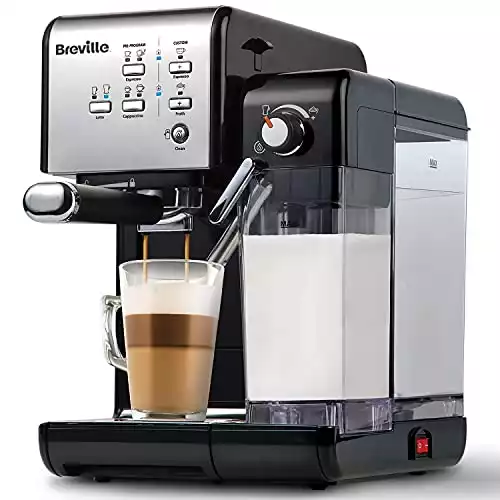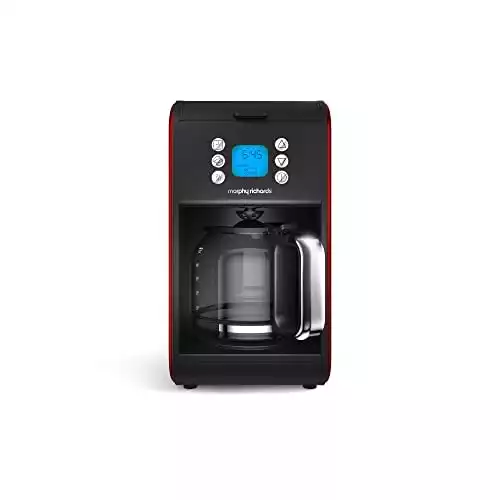If you own a coffee machine, it’s likely that you use it everyday and may just leave it sitting turned on at the wall to use it as and when you need to. But, you may be surprised at how quickly coffee makers add to your annual energy bill.
Not to worry though, you don’t need to give up on your favourite hot drink. Instead, you should be evaluating how much energy your machine actually uses, and seek more energy efficient ways to have your coffee.
|
4.5
|
3.5
|
|
|
N/A
|
How much energy does a coffee machine use?
Did you know the wattage of your coffee machine will differ depending on what kind of coffee machine you use? All coffee machines will work on 240v power, but the wattage can really differ.
We’ve broken down the wattage of the most popular coffee machines below:
Espresso Machines
Espresso machines use the most amount of electricity out of all types of coffee machines. They heat the water and pressurise it to pressure far higher than single-serve coffee machines, which gives the espresso its distinctive flavour.
Espresso machines are best for small servings if you are trying to be energy conscious. If you wanted to make 10 espresso shots, it would take around 1.56 kilowatt-hours of energy, as they use around 1000 to 1500 watts of power.
Filter Drip Coffee Machines
Standard filter coffee machines use the least amount of electricity out of all the coffee machines on our list. They use as little as 650 watts depending on the model you choose.
A huge amount of this energy is used to heat the water in the machine to around 95 degrees Celsuis. The machines, however, will usually keep the carafe heated for about 2 hours until they automatically shut off.
Single Serve Coffee Machines
A single-serve coffee machine, also known as a pod coffee machine, uses more energy than a standard drip coffee machine, but is less expensive than an espresso machine.
A single pour in a single-serve coffee machine will use about 300 watts. This type of machine uses the wattage in two ways: to heat the water and to pressurise it and run it through the coffee pod.
Although they use a relatively low wattage, they are criticised for not being eco-friendly. The pods which are used for these coffee machines are usually single use and made of plastic. You can buy reusable coffee pods made from metal if you use this type of coffee machine, and wish to be more eco-friendly.
Combination Coffee Machines
There are a number of coffee machines which combine two coffee makers together, such as an espresso machine being combined with a single-serve coffee machine.
These machines are the average of energy consumption, allowing you to brew coffee in different ways that can be more energy efficient. The most common combination coffee machine uses around 1,350 watts of power.
Running costs of a coffee machine in the UK
In the UK, it costs on average 47p per hour to run a coffee machine on maximum power.
However, the price can range from 10-50p per hour depending on which machine you choose. And the price you pay per KWh of electric. Based on the UK’s recently announced Energy price cap of 36p per KWh.
The average energy consumption for a coffee machine we worked out at 1.3KWh.
To work out the running costs of your coffee machine, simply multiply your consumption (in kWh) by the price you pay per kWh.
Coffee machine energy usage vs an electric kettle
In terms of coffee quality, coffee makers deliver high quality coffee instantly. However, if you’re using an electric kettle, it’s likely you’ll need an additional device, such as a French press.
However, the environmental impact and cost of coffee machines tends to be higher than electric kettles. Whilst the wattage of an electric kettle is higher than a single serve coffee machine, it is slightly more energy efficient as users tend to overfill more than one cups worth of water.
Financially speaking, the small difference between use of a coffee machine and an electric kettle is not substantial.
If you use your kettle or coffee machine only when needed and turn it off when you’re not using it, a coffee machine will generally be more efficient for coffee drinkers.
How to reduce your coffee machine’s energy consumption
If you are conscious of your coffee machine’s energy usage, do not worry. We’ve listed our top four tips for reducing running costs:
- Unplug: Instead of leaving it to consume energy, unplug your coffee machine or turn it off at the wall and only plug it back in/switch it on when needed.
- Use when needed only: Just like a TV being on standby, coffee machines continue to consume electricity when idle and many also heat up when idle too.
This can be convenient when you want a hot coffee on demand, but there is a significant amount of power wasted in doing so. Only use your machine when needed to help to reduce your energy bills and carbon footprint. - Consider new models: Many modern coffee machines have power saving features, such as an auto turn off. If you have an older model, it may be a good idea to upgrade it to a newer, more energy efficient model.
- Turn down the temperature: If your machine has a max temperature feature, you could turn it to a lower temperature so it consumes less electricity.
Energy efficient coffee machines
Breville
The Breville One-Touch CoffeeHouse Coffee Machine is the perfect choice for having barista quality at home.
The easy to use machine offers superior performance and high quality results, all whilst having a wattage of 1100 watts. The machine also comes with a handy milk frother, perfect for cappuccinos and lattes.
Morphy Richards
The Morphy Richards 162009 Pour Over Filter Coffee Maker is ideal for those looking for a standard filter coffee machine. With easy to use settings, a reusable filter and a timer function, this coffee machine is perfect for the home or office environment.
It also has a power of 900 watts and a generous capacity of 1.8 litres for up to 12 cups of coffee.
FAQs about coffee machine energy usage
Do coffee machines use a lot of electricity?
Generally speaking, coffee machines do not use a lot of electricity, and most of the electricity used is to simply heat the water and keep the brewed coffee hot.
Despite the fact the initial energy use can be high, your coffee machine may not use all of the energy once your cup of coffee is done.
Does a coffee machine use power when turned off?
Yes, coffee machines still use power simply by being plugged into a power outlet even when they are turned off.
These types of machines use what is known as “phantom power”. To prevent this, you should unplug your machine when you’re not using it, or turn it off by the switch, in order to save money on your energy bills.







